Is organic wine better for the environment than conventional wine? Slate contributor Brian Palmer wonders in his recent article.
Isn't the answer obvious? Conventional viticulture has serious environmental issues such as soil depletion, water pollution, loss of biodiversity, and resistance to pests. On the other hand, organic viticulture produces crops that are healthier, more drought tolerant, more resistant to diseases and pests, and can better compete with weeds. But in reality, viticulture is only one of many factors that contribute to the environmental impact of a bottle of wine. Other major factors are winemaking practices, packaging, and shipping.
This interesting study attempts to quantify the greenhouse gas emissions of a bottle of wine and compares various production and transportation scenarios. It shows that the difference in terms of greenhouse gas emissions, between organic and conventional viticulture is relatively small, although this could change if the cost of fossil fuel increases in the future. The CO2 emissions that occur during fermentation are also small. They represent less than 3% of the overall amount of CO2 emissions for one bottle of wine. However, aging wine in oak barrels is more costly for the environment than aging in stainless steel tanks, especially if barrels are imported and new oak is used every year.
Actually, the study shows that the greatest impact on the greenhouse effect from the wine supply chain comes from transportation, and this includes the transport of empty bottles to the winery and full bottles to the customers. The cost tends to be much higher for these ultra premium wines in thick, oversized bottles. In fact, it is far more “green” to use boxed wines or Tetra Pak packaging.
If you live in New York, it is also greener to drink a bottle of wine from Bordeaux that has travelled in a container across the Atlantic than a wine from Napa that came across the country in a truck. Now, for us Californians, what is the price of enjoying a bottle of Bordeaux without being too bothered by our green conscience?
Technorati tags: wine food & drink
The smell of wine, oh how much more delicate, cheerful, gratifying, celestial and delicious it is than that of oil. François Rabelais (1495-1553)
Friday, March 25, 2011
Tuesday, March 15, 2011
How to remove red wine stains
At our last wine tasting event, one of our guests had some red wine spilled on his shirt. This is quite unfortunate but these kinds of incidents do happen so is there a safe way to remove red wine stains without damaging the fabric?
After a little bit of internet search, I found several effective methods that can be used depending on where you are (at home, in a restaurant) and what you have immediately within reach.
First of all, red wine stains need to be taken care of right away before they set. So check the label. If it is dry clean only, take the garment as fast as you can to the cleaners.
Otherwise, the idea is to dilute the stain's red pigmentation. One way is to blot the stain with a mixture of laundry soap and hydrogen peroxide. But test one small area first to make sure it does not discolor the fabric. Don't rub it, this would set the stain deeper within the fabric.
Another method is to blot the stain with club soda and let it bubble up. White wine can also be used because it dilutes the wine's red pigments. Surprisingly, milk is good too because it contains some enzymes that can discolor the stain. Allow the milk to remain on the stain for a good amount of time.
Following a different strategy, you can try to immediately absorb most of the stain with salt, cornstarch, talcum powder, or even baking soda. Once you have blotted as much of the stain, gently brush the powder off from the fabric.
How to Remove Red Wine from Fabric
Red Wine Stain Removal Methods
How to Get Rid of Red Wine Stains
Technorati tags: wine food & drink
After a little bit of internet search, I found several effective methods that can be used depending on where you are (at home, in a restaurant) and what you have immediately within reach.
First of all, red wine stains need to be taken care of right away before they set. So check the label. If it is dry clean only, take the garment as fast as you can to the cleaners.
Otherwise, the idea is to dilute the stain's red pigmentation. One way is to blot the stain with a mixture of laundry soap and hydrogen peroxide. But test one small area first to make sure it does not discolor the fabric. Don't rub it, this would set the stain deeper within the fabric.
Another method is to blot the stain with club soda and let it bubble up. White wine can also be used because it dilutes the wine's red pigments. Surprisingly, milk is good too because it contains some enzymes that can discolor the stain. Allow the milk to remain on the stain for a good amount of time.
Following a different strategy, you can try to immediately absorb most of the stain with salt, cornstarch, talcum powder, or even baking soda. Once you have blotted as much of the stain, gently brush the powder off from the fabric.
How to Remove Red Wine from Fabric
Red Wine Stain Removal Methods
How to Get Rid of Red Wine Stains
Technorati tags: wine food & drink
Thursday, March 10, 2011
A hearty Sauerkraut with some wines from Eastern Europe
A little while ago, we had a small gathering at my house to taste some Eastern European wines around a sauerkraut dish cooked with carrots, onions, apples, riesling, and juniper berries, and accompanied by braised pork chops, sausages, and potatoes. Most of our wines came from Austria, a major producer of aromatic dry white wines made mostly from the local Grüner Veltliner grape, although red wine production accounts for 30% of all Austrian wines. We also had a red wine from Slovenia, a country that has been producing wine since the time of the prehistoric Celts. Finally, we ended that excellent evening with a Tokay from Hungary, a wine that is believed to be the world's oldest botrytis wine.
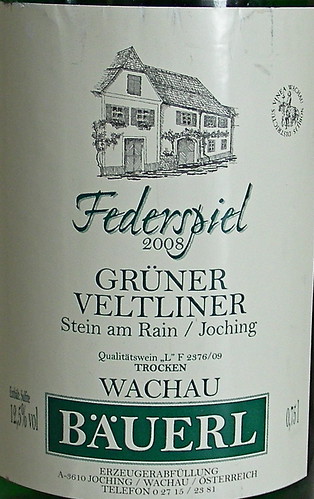 We had our first wine, the 2008 Bäuerl Stein am Rain Grüner Veltliner Federspiel with an appetizer of hungarian peppers. Grüner Veltliner is the most widely planted grape variety in Austria. Grüner means green in German as the grape tends to produce fresh and youthful wines. It grows well along the Danube river on steep, rocky river banks, as steep as those found in the Mosel wine region.
We had our first wine, the 2008 Bäuerl Stein am Rain Grüner Veltliner Federspiel with an appetizer of hungarian peppers. Grüner Veltliner is the most widely planted grape variety in Austria. Grüner means green in German as the grape tends to produce fresh and youthful wines. It grows well along the Danube river on steep, rocky river banks, as steep as those found in the Mosel wine region.
Weingut Bäuerl is located in the Wachau, the part of the Danube valley between the village of Melks and Krems and one of Austria's westernmost wine-growing regions. The estate grows only white varieties: Grüner Veltliner (55%), Riesling (35%) and Muskateller (10%), and practices organic and sustainable viticulture. My notes: medium golden color, nose of green apple, pear, and honey. On the palate, smooth, juicy, and quite mineral. Good finish, nice appetite opener.
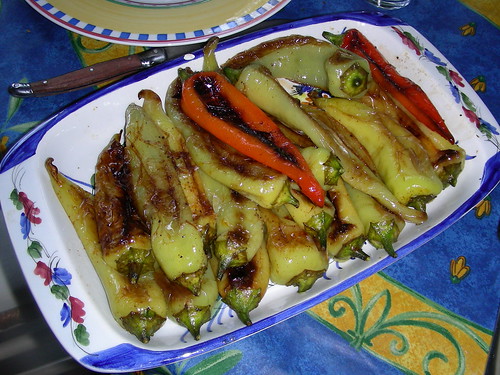
Hungarian Peppers
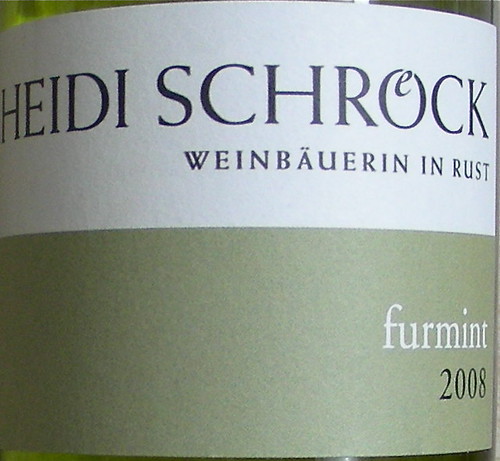 The next two wines were served with the sauerkraut. We started with the 2008 Heidi Schröck Ruster Furmint. Furmint is most widely grown in Hungary and is the main grape variety of Tokay, Hungary's famous dessert wine. It is also found in Austria's Burgenland, near the Hungarian border.
The next two wines were served with the sauerkraut. We started with the 2008 Heidi Schröck Ruster Furmint. Furmint is most widely grown in Hungary and is the main grape variety of Tokay, Hungary's famous dessert wine. It is also found in Austria's Burgenland, near the Hungarian border.
Heidi Schröck is a small 8 hectare estate located in Rust, Burgenland, on the west side of Neusiedlersee. Neusiedlersee or Lake Neusiedl is the second largest steppe lake in Central Europe at the border of Austria and Hungary. The lake stores heat and regulates the region's climate. Thanks to warm and humid autumns, it also provides the best conditions for the production of botrytized dessert wines. My notes: this Furmint is actually completely dry. The wine is crisp, mineral with aromas of ripe apple and spices. Very distinctive and quite popular with the dinner guests.
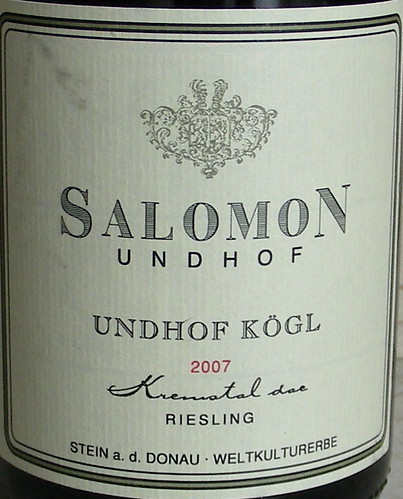 Also with the sauerkraut, we also tasted the 2007 Salomon Undhof Kögl Riesling. Founded in 1792, Salomon Undhof is a Wachau estate that produces white wines from the best terraced sites along the Danube River. The 25 hectares of Salomon Undhof's vineyards are planted with roughly half Riesling, half Grüner Veltliner. All the grapes are harvested traditionally by hand. Undhof Kögl is a south facing terraced single vineyard with highly weathered soil of crystalline schist bedrock. My notes: light color, acacia flowers, stone fruits on the nose. Dry, slightly fizzy on the palate, fresh and crisp with citrus flavors and spices on the finish. I thought it worked really well with the sauerkraut.
Also with the sauerkraut, we also tasted the 2007 Salomon Undhof Kögl Riesling. Founded in 1792, Salomon Undhof is a Wachau estate that produces white wines from the best terraced sites along the Danube River. The 25 hectares of Salomon Undhof's vineyards are planted with roughly half Riesling, half Grüner Veltliner. All the grapes are harvested traditionally by hand. Undhof Kögl is a south facing terraced single vineyard with highly weathered soil of crystalline schist bedrock. My notes: light color, acacia flowers, stone fruits on the nose. Dry, slightly fizzy on the palate, fresh and crisp with citrus flavors and spices on the finish. I thought it worked really well with the sauerkraut.
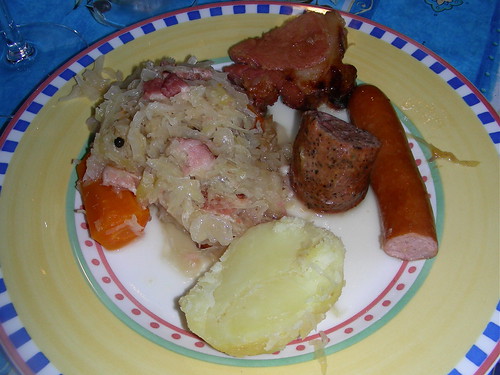
Our Sauerkraut
 We had the next two reds with cheese and a berry pie. Our first red was the 2004 Wenzel Bandkraften Blaufränkisch. Weingut Wenzel is located in the Neusiedlersee-Hügelland wine-growing region. 60% of the 11 hectare vineyard is planted with the white varieties Furmint, Gelber Muskateller, Sauvignon Blanc, Pinot Gris, and Welschriesling, the remaining 40% is planted with the red varieties Blaufränkisch, Pinot Noir, and Merlot. Blaufränkisch is the second most important red grape variety in Austria after Zweigelt. It produces spicy wines rich in tannins. My notes: medium red color. Mocha and vanilla aromas on the nose. Full-bodiedood with wood and black cherry on the palate. Not as easy to drink as the next wine.
We had the next two reds with cheese and a berry pie. Our first red was the 2004 Wenzel Bandkraften Blaufränkisch. Weingut Wenzel is located in the Neusiedlersee-Hügelland wine-growing region. 60% of the 11 hectare vineyard is planted with the white varieties Furmint, Gelber Muskateller, Sauvignon Blanc, Pinot Gris, and Welschriesling, the remaining 40% is planted with the red varieties Blaufränkisch, Pinot Noir, and Merlot. Blaufränkisch is the second most important red grape variety in Austria after Zweigelt. It produces spicy wines rich in tannins. My notes: medium red color. Mocha and vanilla aromas on the nose. Full-bodiedood with wood and black cherry on the palate. Not as easy to drink as the next wine.
 Our second red was the 2007 Santomas Big Red Refosk. Located in the village of Smarje in Slovenian Istria, just southeast of Trieste, Santomas is a family-owned winery overlooking the Adriatic Sea. The area is the warmest wine region in Slovenia so the local wine production is mostly red. The winery currently farms 19 hectares of vineyards planted with traditional varieties like Refosco and Istrian Malvasia, as well as international grapes like Cabernet Sauvignon and Merlot. Refosco is a Northern Italian red grape variety that mostly grows in Friuli, Gavi, and Trentino. In Slovenian Istria, it is also known as Refosk. The grape produce deep colored wines that can be quite powerful and tannic. My notes: dark purple color. Smoky nose with black cherry and blackberry aromas. Fruity with bright acidity on the palate. Quite popular with the cheese.
Our second red was the 2007 Santomas Big Red Refosk. Located in the village of Smarje in Slovenian Istria, just southeast of Trieste, Santomas is a family-owned winery overlooking the Adriatic Sea. The area is the warmest wine region in Slovenia so the local wine production is mostly red. The winery currently farms 19 hectares of vineyards planted with traditional varieties like Refosco and Istrian Malvasia, as well as international grapes like Cabernet Sauvignon and Merlot. Refosco is a Northern Italian red grape variety that mostly grows in Friuli, Gavi, and Trentino. In Slovenian Istria, it is also known as Refosk. The grape produce deep colored wines that can be quite powerful and tannic. My notes: dark purple color. Smoky nose with black cherry and blackberry aromas. Fruity with bright acidity on the palate. Quite popular with the cheese.
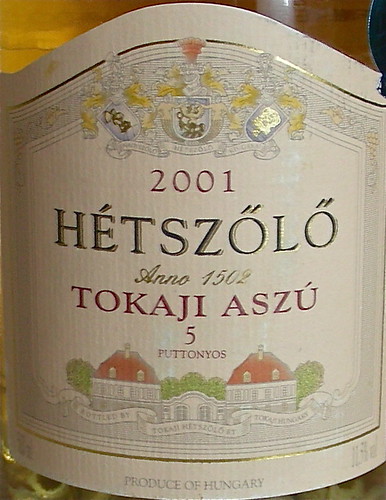 Our last wine was the 2001 Hétszölö Tokaji Aszu 5 Puttonyos. The Tokaji wine region, in northeastern Hungary, is characterized by long, warm autumns and misty mornings that favor the development of noble rot. The botrytis-infected grapes called Aszú are harvested manually, one grape at a time. They are then crushed and added to a dry base wine. The proportion of Aszú grapes added to the base wine is measured in puttonyos or baskets. One puttony represents 30 kilos of grapes that are poured into a traditional 126 liter barrel of base wine. The number of puttonyos can vary from 3 to 6 (the highest being the sweetest). The wine is then aged for three years in oak barrels stored in underground cellars. My notes: the Aszú 5 Puttonyos is 90 to 100% Furmint and has a minimum of 120 g/l of residual sugar. Deep golden color. Fresh, fragrant nose of apricot and tropical fruit. On the palate, unctuous texture with lively acidity, zesty kumquat notes on the finish.
Our last wine was the 2001 Hétszölö Tokaji Aszu 5 Puttonyos. The Tokaji wine region, in northeastern Hungary, is characterized by long, warm autumns and misty mornings that favor the development of noble rot. The botrytis-infected grapes called Aszú are harvested manually, one grape at a time. They are then crushed and added to a dry base wine. The proportion of Aszú grapes added to the base wine is measured in puttonyos or baskets. One puttony represents 30 kilos of grapes that are poured into a traditional 126 liter barrel of base wine. The number of puttonyos can vary from 3 to 6 (the highest being the sweetest). The wine is then aged for three years in oak barrels stored in underground cellars. My notes: the Aszú 5 Puttonyos is 90 to 100% Furmint and has a minimum of 120 g/l of residual sugar. Deep golden color. Fresh, fragrant nose of apricot and tropical fruit. On the palate, unctuous texture with lively acidity, zesty kumquat notes on the finish.
Technorati tags: wine food & drink
 We had our first wine, the 2008 Bäuerl Stein am Rain Grüner Veltliner Federspiel with an appetizer of hungarian peppers. Grüner Veltliner is the most widely planted grape variety in Austria. Grüner means green in German as the grape tends to produce fresh and youthful wines. It grows well along the Danube river on steep, rocky river banks, as steep as those found in the Mosel wine region.
We had our first wine, the 2008 Bäuerl Stein am Rain Grüner Veltliner Federspiel with an appetizer of hungarian peppers. Grüner Veltliner is the most widely planted grape variety in Austria. Grüner means green in German as the grape tends to produce fresh and youthful wines. It grows well along the Danube river on steep, rocky river banks, as steep as those found in the Mosel wine region.Weingut Bäuerl is located in the Wachau, the part of the Danube valley between the village of Melks and Krems and one of Austria's westernmost wine-growing regions. The estate grows only white varieties: Grüner Veltliner (55%), Riesling (35%) and Muskateller (10%), and practices organic and sustainable viticulture. My notes: medium golden color, nose of green apple, pear, and honey. On the palate, smooth, juicy, and quite mineral. Good finish, nice appetite opener.

Hungarian Peppers
 The next two wines were served with the sauerkraut. We started with the 2008 Heidi Schröck Ruster Furmint. Furmint is most widely grown in Hungary and is the main grape variety of Tokay, Hungary's famous dessert wine. It is also found in Austria's Burgenland, near the Hungarian border.
The next two wines were served with the sauerkraut. We started with the 2008 Heidi Schröck Ruster Furmint. Furmint is most widely grown in Hungary and is the main grape variety of Tokay, Hungary's famous dessert wine. It is also found in Austria's Burgenland, near the Hungarian border. Heidi Schröck is a small 8 hectare estate located in Rust, Burgenland, on the west side of Neusiedlersee. Neusiedlersee or Lake Neusiedl is the second largest steppe lake in Central Europe at the border of Austria and Hungary. The lake stores heat and regulates the region's climate. Thanks to warm and humid autumns, it also provides the best conditions for the production of botrytized dessert wines. My notes: this Furmint is actually completely dry. The wine is crisp, mineral with aromas of ripe apple and spices. Very distinctive and quite popular with the dinner guests.
 Also with the sauerkraut, we also tasted the 2007 Salomon Undhof Kögl Riesling. Founded in 1792, Salomon Undhof is a Wachau estate that produces white wines from the best terraced sites along the Danube River. The 25 hectares of Salomon Undhof's vineyards are planted with roughly half Riesling, half Grüner Veltliner. All the grapes are harvested traditionally by hand. Undhof Kögl is a south facing terraced single vineyard with highly weathered soil of crystalline schist bedrock. My notes: light color, acacia flowers, stone fruits on the nose. Dry, slightly fizzy on the palate, fresh and crisp with citrus flavors and spices on the finish. I thought it worked really well with the sauerkraut.
Also with the sauerkraut, we also tasted the 2007 Salomon Undhof Kögl Riesling. Founded in 1792, Salomon Undhof is a Wachau estate that produces white wines from the best terraced sites along the Danube River. The 25 hectares of Salomon Undhof's vineyards are planted with roughly half Riesling, half Grüner Veltliner. All the grapes are harvested traditionally by hand. Undhof Kögl is a south facing terraced single vineyard with highly weathered soil of crystalline schist bedrock. My notes: light color, acacia flowers, stone fruits on the nose. Dry, slightly fizzy on the palate, fresh and crisp with citrus flavors and spices on the finish. I thought it worked really well with the sauerkraut.
Our Sauerkraut
 We had the next two reds with cheese and a berry pie. Our first red was the 2004 Wenzel Bandkraften Blaufränkisch. Weingut Wenzel is located in the Neusiedlersee-Hügelland wine-growing region. 60% of the 11 hectare vineyard is planted with the white varieties Furmint, Gelber Muskateller, Sauvignon Blanc, Pinot Gris, and Welschriesling, the remaining 40% is planted with the red varieties Blaufränkisch, Pinot Noir, and Merlot. Blaufränkisch is the second most important red grape variety in Austria after Zweigelt. It produces spicy wines rich in tannins. My notes: medium red color. Mocha and vanilla aromas on the nose. Full-bodiedood with wood and black cherry on the palate. Not as easy to drink as the next wine.
We had the next two reds with cheese and a berry pie. Our first red was the 2004 Wenzel Bandkraften Blaufränkisch. Weingut Wenzel is located in the Neusiedlersee-Hügelland wine-growing region. 60% of the 11 hectare vineyard is planted with the white varieties Furmint, Gelber Muskateller, Sauvignon Blanc, Pinot Gris, and Welschriesling, the remaining 40% is planted with the red varieties Blaufränkisch, Pinot Noir, and Merlot. Blaufränkisch is the second most important red grape variety in Austria after Zweigelt. It produces spicy wines rich in tannins. My notes: medium red color. Mocha and vanilla aromas on the nose. Full-bodiedood with wood and black cherry on the palate. Not as easy to drink as the next wine. Our second red was the 2007 Santomas Big Red Refosk. Located in the village of Smarje in Slovenian Istria, just southeast of Trieste, Santomas is a family-owned winery overlooking the Adriatic Sea. The area is the warmest wine region in Slovenia so the local wine production is mostly red. The winery currently farms 19 hectares of vineyards planted with traditional varieties like Refosco and Istrian Malvasia, as well as international grapes like Cabernet Sauvignon and Merlot. Refosco is a Northern Italian red grape variety that mostly grows in Friuli, Gavi, and Trentino. In Slovenian Istria, it is also known as Refosk. The grape produce deep colored wines that can be quite powerful and tannic. My notes: dark purple color. Smoky nose with black cherry and blackberry aromas. Fruity with bright acidity on the palate. Quite popular with the cheese.
Our second red was the 2007 Santomas Big Red Refosk. Located in the village of Smarje in Slovenian Istria, just southeast of Trieste, Santomas is a family-owned winery overlooking the Adriatic Sea. The area is the warmest wine region in Slovenia so the local wine production is mostly red. The winery currently farms 19 hectares of vineyards planted with traditional varieties like Refosco and Istrian Malvasia, as well as international grapes like Cabernet Sauvignon and Merlot. Refosco is a Northern Italian red grape variety that mostly grows in Friuli, Gavi, and Trentino. In Slovenian Istria, it is also known as Refosk. The grape produce deep colored wines that can be quite powerful and tannic. My notes: dark purple color. Smoky nose with black cherry and blackberry aromas. Fruity with bright acidity on the palate. Quite popular with the cheese. Our last wine was the 2001 Hétszölö Tokaji Aszu 5 Puttonyos. The Tokaji wine region, in northeastern Hungary, is characterized by long, warm autumns and misty mornings that favor the development of noble rot. The botrytis-infected grapes called Aszú are harvested manually, one grape at a time. They are then crushed and added to a dry base wine. The proportion of Aszú grapes added to the base wine is measured in puttonyos or baskets. One puttony represents 30 kilos of grapes that are poured into a traditional 126 liter barrel of base wine. The number of puttonyos can vary from 3 to 6 (the highest being the sweetest). The wine is then aged for three years in oak barrels stored in underground cellars. My notes: the Aszú 5 Puttonyos is 90 to 100% Furmint and has a minimum of 120 g/l of residual sugar. Deep golden color. Fresh, fragrant nose of apricot and tropical fruit. On the palate, unctuous texture with lively acidity, zesty kumquat notes on the finish.
Our last wine was the 2001 Hétszölö Tokaji Aszu 5 Puttonyos. The Tokaji wine region, in northeastern Hungary, is characterized by long, warm autumns and misty mornings that favor the development of noble rot. The botrytis-infected grapes called Aszú are harvested manually, one grape at a time. They are then crushed and added to a dry base wine. The proportion of Aszú grapes added to the base wine is measured in puttonyos or baskets. One puttony represents 30 kilos of grapes that are poured into a traditional 126 liter barrel of base wine. The number of puttonyos can vary from 3 to 6 (the highest being the sweetest). The wine is then aged for three years in oak barrels stored in underground cellars. My notes: the Aszú 5 Puttonyos is 90 to 100% Furmint and has a minimum of 120 g/l of residual sugar. Deep golden color. Fresh, fragrant nose of apricot and tropical fruit. On the palate, unctuous texture with lively acidity, zesty kumquat notes on the finish.Technorati tags: wine food & drink
Subscribe to:
Comments (Atom)